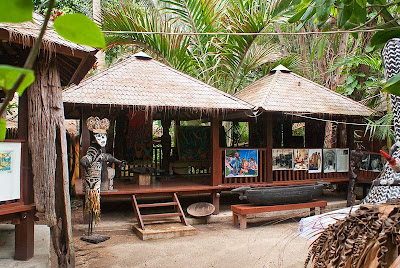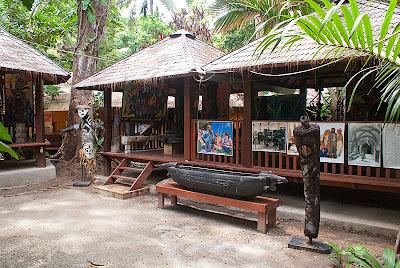Bicentennary of russian admiral Golovnin who visited Port Resolution 200 years ago and 30 years after Captain Cook on 26 july 1809. This year amaizingly we celebrate the bicentenary started by our foundation based since 1978 in vanuatu. It is under the patronage of the foreign ministry ministry of the interior & the municipality of Port-Vila. Visit by the Russian Ambassador Canberra, visit of the newly appointed honorary consul of vanuatu in Russia. General Bolchakoff the famous sculptor from Moscow Vassili Selivanov by the photo ansd nes reporter A.koulechoff who is going to make a photo of the exhibitions held in Russia by invitation of the Academy of Sciences of USSR by the two vanuatu artists PILIOKO-MICHOUTOUCHKINE over 8 years from 1979 until1988 and the visit of Russian orthodox priest to bless the inauguration of Golovnin Statue on the water front.



1809 - 2009 : Bicentenaire de la commémoration
du premier contact entre le Vanuatu et la Russie.


On 25 July 1807 the Russian sloop “Diana” under the command of V.M. Golovnin with a young crew of fifty-five sailed from Kronstadt, a Russian seaport town in the Gulf of Finland, to Petropavlovsk-in-Kamchatka in the far east of the country. Its voyage was one of provisioning to the new Russian settlements in the Far East and North America as well as of surveying and discovery in North Pacific waters.
On 26 July 1809 the sloop found itself entering a small bay in the tropical Pacific named by Captain Cook “Port Resolution” and by Tanna islanders – “Uea”, in the dark, volcanic lee of Mount Yasur. “Diana” had no orders to call at Tanna Island - her arrival was a consequence of a dramatic and unlikely series of events, including capture by the British, an escape from Simon's Bay in South Africa, at dusk and in a storm, and an exhausting, uninterrupted passage across the Indian Ocean and Tasman Sea with the intention of avoiding all encounters with the British fleet or British merchantmen in Australian waters. Tanna was chosen by V.M. Golovnin as their resting and revitalizing spot, well removed from normal shipping routes and likely to be free of Europeans, yet supplied with ample fruit, some drinking water, and a neatly charted harbour.
All, in fact, passed off as well as Golovnin could have desired, after tense initial meetings with a Kwamera-speaking Tannese group led by an elder called Gunama. Drawing maximum advantage from the works of the two Forsters who, had been at Tanna with “Resolution” in 1774, Golovnin proceeded cautiously but amicably. A single day produced, through barter at the water's edge, some forty feet of sugarcane, 400 coconuts or more, and yams. Uea Bay, meanwhile, was surveyed by cutter, and Tannese weaponry and other artifacts were collected and can be now seen at St. Petersburg Kunstcamera Museum. Full notes were taken about the evidence of tribal warfare, social structure, navigation, husbandry and diet, clothing, ornament, and language.
“Diana’s” visit to Uea Bay was beneficial in both practical and scientific terms.
This stamp issue marks 200 years since the first Russian-Vanuatu contact, which continues today and will be celebrated on 25 July 2009 in Port Vila.
For more information please contact:
For more contact Aloï : 7747753
or
For more contact Aloï : 7747753
or
The Manager,
Philatelic Bureau,
Vanuatu Post, Port Vila, Vanuatu.
Tel. + 678 22000,
Fax + 678 23900
E mail: philatelic@vanuatupost.vu
www.vanuatupost.vu
50 ans de création en Océanie
Le vernissage de l'exposition « 50 ans de création en Océanie » s'est déroulé le 10 décembre, dans les « chemins de verdure » de la propriété de la « Fondation Nicolai Michoutouchkine et Aloi Pilioko, artistes-peintres » de grande renommée, avec la participation de l'Ambassadrice de France au Vanuatu et d'un public nombreux d'autorités locales, de diplomates, d'artistes internationaux et locaux, d'amis et de curieux.

Cette manifestation a reçu le soutien de l’Alliance française, de la délégation de la commission européenne au Vanuatu, et, naturellement, de la Fondation Michoutouchkine. Cette dernière était aussi très engagée, aux côtés du centre culturel Tjibaou et de la délégation de la commission européenne au Vanuatu, dans l’appui à l’exposition organisée à Nouméa, en juillet 2008 sous le même titre. De surcroit, une trentaine de tableaux des deux artistes et plus de deux cents œuvres majeures de leur collection du Pacifique font partie de l’exposition permanente du Museum Pasifika de Bali.
L’exposition-rétrospective de décembre 2008, mise en forme par Paul Gardissat, ami des deux artistes, est ouverte au public pour plusieurs mois.


Les peintres N. Michoutouchkine et Aloi Pilioko se sont employés depuis un demi-siècle à réunir une importante collection d’objets usuels et/ou rituels. Ils les ont exposés en divers lieux du Pacifique, pour faire prendre conscience aux habitants des petits Etats insulaires de la beauté de leurs propres œuvres et de la nécessité de les préserver. Ils ont aussi pu les faire découvrir dans des cadres internationaux prestigieux, tels le centre culturel de Royaumont, le musée d’art moderne de Paris, en Suède, en Suisse, en Pologne, dans les anciennes républiques d’Union soviétique, dans toute l’Asie du sud-est, à Taipei et en Australie.
Ce faisant, ils ont pris grand soin de replacer ces œuvres dans le volume pour lequel elles avaient été conçues, en mettant en valeur, la perfection de ces objets, la créativité des artistes océaniens et leur influence sur tous les grands peintres modernes Picasso, Matisse, Max Ernst, Veira de Silva, Barr Sharrar...). Ces derniers, dans les années 30, avaient déniché certaines œuvres d’artistes océaniens qui ont contribué à renouveler leur vision et à remodeler leur inspiration.


Cette exposition reflète la passion qui anime ces deux artistes, les œuvres et lieux prestigieux de leur cheminement artistique.
L’exposition-rétrospective de décembre 2008, mise en forme par Paul Gardissat, ami des deux artistes, est ouverte au public pour plusieurs mois.


Les peintres N. Michoutouchkine et Aloi Pilioko se sont employés depuis un demi-siècle à réunir une importante collection d’objets usuels et/ou rituels. Ils les ont exposés en divers lieux du Pacifique, pour faire prendre conscience aux habitants des petits Etats insulaires de la beauté de leurs propres œuvres et de la nécessité de les préserver. Ils ont aussi pu les faire découvrir dans des cadres internationaux prestigieux, tels le centre culturel de Royaumont, le musée d’art moderne de Paris, en Suède, en Suisse, en Pologne, dans les anciennes républiques d’Union soviétique, dans toute l’Asie du sud-est, à Taipei et en Australie.
Ce faisant, ils ont pris grand soin de replacer ces œuvres dans le volume pour lequel elles avaient été conçues, en mettant en valeur, la perfection de ces objets, la créativité des artistes océaniens et leur influence sur tous les grands peintres modernes Picasso, Matisse, Max Ernst, Veira de Silva, Barr Sharrar...). Ces derniers, dans les années 30, avaient déniché certaines œuvres d’artistes océaniens qui ont contribué à renouveler leur vision et à remodeler leur inspiration.


Cette exposition reflète la passion qui anime ces deux artistes, les œuvres et lieux prestigieux de leur cheminement artistique.